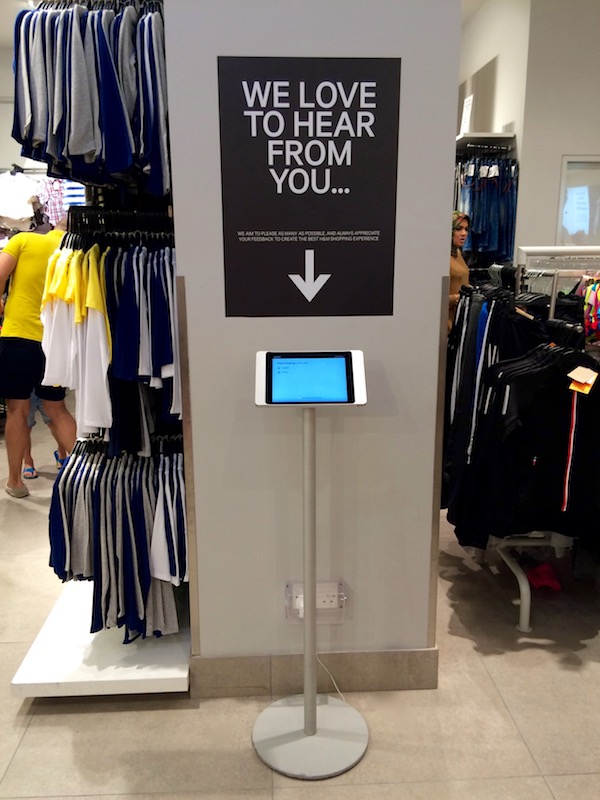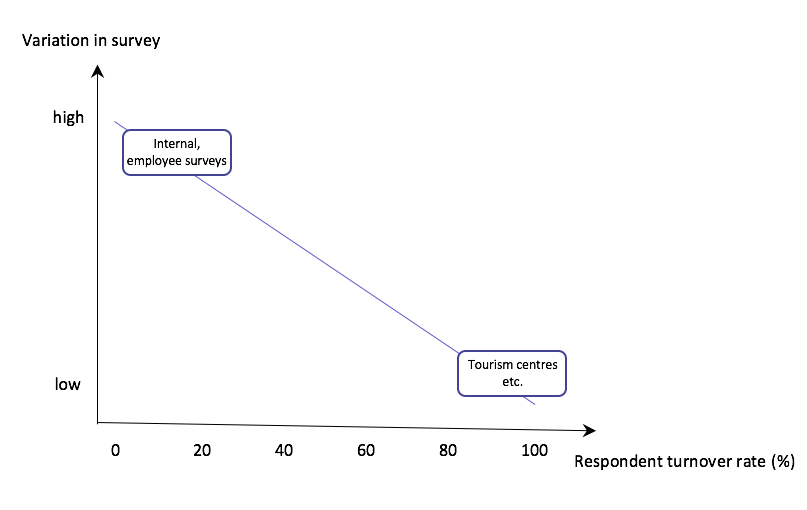In this blog post I want to shed light on factors that can influence the response rate if you are performing Surveys On The Go in general.
What are Surveys On The Go?
By Surveys On The Go I mean the type of survey which are available in the physical space and captures responses quickly and here and now. Obviously, the survey itself matters: the questions you ask and how your engage with your visiting audience. If you are interested in survey design in general and which survey strategy to adapt, you can read about it here and here. However, there are some other, external factors that can affect your response rate. One of these elements are the respondent turnover rate.
What is your respondent turnover rate?
The respondent turnover rate is defined by how quickly the population of respondents (surveyees) changes over time in the physical location you are surveying. For instance, if you are a retailer, and you are surveying your visiting customers, then your respondent turnover rate would be the number of new visitors your store gets divided by the number of total visitors. Imagine that your store receives 1,000 monthly visitors. Of these 300 visited your store the month before, and so they are repeat visitors. Your respondent turnover rate would be (300/1,000) x 100 = 30 percent.

A place where the turnover rate is even higher would be in a Tourism Information Center or Welcoming Center. Naturally, the turnover rate would be high here because very few tourists would visit a welcoming center more than once. Therefore, the turnover rate would be close to 100 percent, as almost every visitor is new and unique.
At the other end of the scale, consider the cafeteria of a company. The employees here are asked about the satisfaction with the warm meal – every day. The respondent turnover rate here is close to zero.
In the examples given above, the overall motivation for answering a survey is, among other factors, dependent on the respondent turnover rate. I.e. the more times the respondent sees the same survey, the less motivated she would be to answer it. This is why you cannot apply the same kind of logic when performing, say, an employee engagement survey and a visitor center survey. Apart from the fact that there is a big difference in the composition of the respondents, there are some other factors that could affect your response rates.
Asking someone raises their expectations
Consider your company was surveying you in your cafeteria every day and that they asked the same question everyday: ”How did you like the warm dish today?”. The first time they ask, you rate it mediocre and comment that the chicken was dry. The following week, you get chicken again, and guess what: It’s still dry. When experiencing the dry chicken once again the third week, you simply don’t answer anymore, because what’s the point, right?
The lesson to be learned is that the lower the turnover rate of the respondents is, the more important it is for you as survey creator to ensure that the surveys you present are variated. Please see the below graph depicting a simplified correlation between survey variation and respondent turnover rate.

Ways to increase the response rate if respondent turnover rate is low
Areas where the respondent turnover rate is typically low includes: Internal employee engagement surveys, facility management services (like printing, cleaning, cafeteria etc.), educational institutions, and food businesses that have a very frequent, regular customer base.
For these and related segments, we recommend some of the following ways to increase the response rate for your surveys.
- Stop-go approach. One solution is not to monitor continuously, but instead apply a stop-go approach. For instance, to survey for 1-2 weeks and then stop the survey for another 1-2 weeks.
- Acknowledge and visualise results. In itself or in conjunction with the stop-go approach, a good way to spend the weeks of not surveying would be to acknowledge the feedback received, for instance by sharing the feedback with the respondents (customers, visitors, employees). This would create a common understanding of what feedback was given and identify what, if anything, needs to be changed.
- Act. Acting on the results from any survey ensures high motivation from the respondents and raises the chances of higher completion rates in the future.
- Change some questions. Keep some overall base questions but vary others to keep the survey from being too boring.
Dry chicken example revisited
So if you are asking about the warm meal of the day. Then follow up in the coming weeks with a different question, like: ”Is the chicken still dry?” or “If we were to change the menu away from chicken, what would you prefer, we changed it to?” (with alternatives). That way, you are signaling that you are actually listening and want to improve the services you provide.
Anyway, would love to hear your thoughts on this subject. Have you or are you performing surveys on the go in areas where the same people are passing through? How do you engage your respondents?